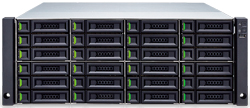RAID LEVELS
RAID LEVEL 5: JetStor RAID Level 5 Storage Systems for Sale
Each entire data block is written on a data disk; parity for blocks in the same rank is generated on Writes, recorded in a distributed location and checked on Reads.
RAID Level 5 storage systems require a minimum of 3 drives to implement.

RAID 5 Characteristics & Advantages
- Highest Read data transaction rate
- Medium Write data transaction rate
- Low ratio of ECC (Parity) disks to data disks means high efficiency
- Good aggregate transfer rate
Disadvantages
- Disk failure has a medium impact on throughput
- Most complex controller design
- Difficult to rebuild in the event of a disk failure (as compared to RAID level 1)
- Individual block data transfer rate same as single disk
Recommended Applications
- File and Application servers
- Database servers
- Web, E-mail, and News servers
- Intranet servers
- Most versatile RAID level




